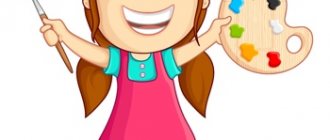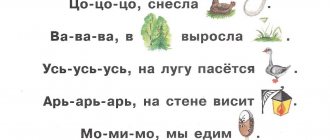Speech map of a child with motor alalia
Speech map of a child with motor alalia
Anamnestic data about the child
| Personal data | Last name, first name of the child ___________________________________________________________________ Date of birth _______________________________________________________________________________ Home address _______________________________________________________________________________ From which preschool institution did _____________________________________________ Date of admission to the group _________________________________________________________________ Conclusion of the PMPK ________________________________________________________________________________ _______________________________________________________________________________________ _______________________________________________________________________________________ _______________________________________________________________________________________ _______________________________________________________________________________________ |
| Parents information | Mom's first name, patronymic, her age _________________________________________________________________ Dad's first name, patronymic, his age _________________________________________________________________________ Other family members _____________________________________________________________________ Parents' complaints _____________________________________________________________________ _______________________________________________________________________________________ _______________________________________________________________________________________ Parents' speech: literacy, correct phrase construction, coherence and logic of messages about their child or errors in the use of words, agrammatisms in the phrase , poverty of linguistic means for expressing one’s thoughts, violation of the coherence and logic of the narrative _______________________________________________________________________________________ Hereditary diseases (presence of speech disorders, neuropsychiatric, chronic diseases in parents and relatives) ________________________________________________________________ ________________________________________________________________________________________________ |
| General anamnesis | What kind of pregnancy is the child from? __________________________________________________________ Nature of pregnancy (falls, injuries, psychosis, toxicosis, threat of miscarriage, chronic and infectious diseases) ____________________________________________________________ ______________________________________________________________________________________________ Childbirth (early, urgent, fast, rapid, protracted, dehydrated) _______________________________________________________________________________________________ Stimulation (mechanical, chemical, electrical stimulation) _________________________________ Screaming: was, no ______________________________________________________________________________ Asphyxia (blue, white) ______________________________________________________________________________ Rhesus factor: negative, compatibility _____________________________________________ Weight and height of the child at birth ____________________________________________________________ Number of points on the Apgar scale ____________________________________________________________ Feeding ___________________________________________________________________________ Sucked actively, fell asleep during feeding, quickly got tired, regurgitated, choked , feeding up to months ________________________________________________________________ Subsequent feeding: mixed, artificial ____________________________________ Additional stay in the maternity hospital, reasons ________________________________________________ Features of early development: holds head from one month, sits from one month, walks from one month, by one year of teeth Previous diseases: up to 1 year ____________________________________________________________ Up to 3 years _______________________________________________________________________________ Organic diseases of the nervous system_______________________________________________ ________________________________________________________________________________________ ________________________________________________________________________________________ ________________________________________________________________________________________ Musculoskeletal disorders________________________________________________ ________________________________________________________________________________________ ________________________________________________________________________________________ Hearing condition_________________________________________________________________________________________ Visual condition_________________________________________________________________________ _________________________________________________________________________________________ Convulsions at high temperatures_________________________________________________________________________ |
Inspection
| № | Organs of articulation | Structural features | Norm |
| 1. | Lips | Thick, thin, short, cheiloskisis (cleft lip), procheilia (increased size of the upper lip, protruding and overhanging it over the lower lip) | Normal structure |
| 2. | Teeth | Rare, crooked, outside the jaw lip, small, large, dentition, presence of diastema | Normal structure |
| 3. | Bite | Prognathia (upper row of teeth protrudes above the lower row), progeny (lower row of teeth protrudes forward), straight (frontal incisors do not overlap each other), cross (displacement of the jaws relative to each other), deep, open (lack of closure between the rows of teeth in the frontal plane ), narrowing of the jaws (unilateral, bilateral), microgenia (small size of the lower jaw) | Orthognathic |
| 4. | Solid sky | Palatoschisis (cleft palate), post-operative scars, high palate, narrow palate | Normal structure |
| 5. | Soft sky | Long, short, with postoperative scars, submucosal fissure, bifurcated | Normal structure |
| 6. | Language | Macroglossia, microglossia, long, short, wide, narrow, massive, hypertrophy of the tongue root, bifurcated, shortened hypoglossal ligament | Normal structure |
Observation
| № | Function | Result | Point |
| 1. | Contact | Doesn't make contact. The contact is formal. He makes contact with difficulty and does not show interest. Contact is selective or establishes contact easily. | 0 1 2 3 |
| 2. | Emotional sphere | Passive, lethargic, inert. Increased emotional excitability, irritability. Mood swings, emotional lability. Active, cheerful, emotional. | 0 1 2 3 |
| 3. | Communication means | Communication is poorly expressed, realized through body movements in combination with an expressionless smile, shouting. Communication through movements of the body, head, smile, voice. Communication through a differentiated voice, facial expressions, expressive gaze, amorphous root words, gestures. Speech means of communication. | 0 1 2 3 |
| 4. | Understanding gestures and facial expressions | Does not understand. Understands specific gestures. Understands nods, pointing gestures, and simple facial expressions. Understands gestures and facial movements. | 0 1 2 3 |
| 5. | Using gestures and facial expressions | Does not use gestures or facial expressions. Shows what is needed by a specific demonstration of an action, by touching an object. Shows objects at a distance, shows with a gesture what is desired. Uses complex facial expressions and gestures. | 0 1 2 3 |
| 6. | Attention | Poor concentration, difficulty maintaining attention on an object. Attention is unstable, superficial, and quickly depleted. The attention is quite stable. Switching duration and attention span by age | 0 1 2 3 |
| 7. | Switchability | Does not switch from one action to another when they change (continues to perform the previous one). To switch from one task to another, a coupled execution of this action is required. Switches from one task to another after presenting a sample of the next action. Easily switches to another task without the organizing help of a teacher. | 0 1 2 3 |
Block: Rhythm Study
| Directions | Criteria for evaluation | Tasks (trials) | Points | |
| Beginning of the year | The end of the year | |||
| Playing simple rhythms | 1 point – correctly and accurately reproduces the rhythm; 0.5 points – the rhythm is distorted, respecting the number of beats; 0.25 points – the rhythm is distorted, not observing the number of beats; 0 points – the rhythm does not reproduce. | Listen and knock like me: XX _____________ XXX ______________ XXXXX ________________ XXX _________ XXX ______________ Total: 5 samples, maximum 5 points. Success rate:____x100:5=______ | ||
Speech therapy conclusion: ______________________________________________ ______________________________________________________________________________ _________________________________________________________________________
________________________________________________________________________
Speech therapy plan: ________________________________________ _________________________________________________________________________ _________________________________________________________________________ _________________________________________________________________________ ________________________________________________________________________ ________________________________________________________________________ ________________________________________________________________________
Date of examination Signature
Speech map of a child with motor alalia







